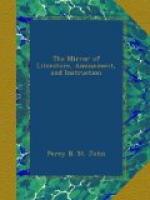beset with hornets and wasps. No other coincidence
could assimilate the tombs of Petrarch and Archilochus.
The revolutions of centuries have spared these sequestered
valleys, and the only violence which has been offered
to the ashes of Petrarch was prompted, not by hate,
but veneration. An attempt was made to rob
the sarcophagus of its treasure, and one of the
arms was stolen by a Florentine through a rent
which is still visible. The injury is not forgotten,
but has served to identify the poet with the country,
where he was born, but where he would not live.
A peasant boy of Arqua being asked who Petrarch
was, replied, “that the people of the parsonage
knew all about him, but that he only knew that
he was a Florentine.”
Every footstep of Laura’s lover has been anxiously traced and recorded. The house in which he lodged is shown in Venice. The inhabitants of Arezzo, in order to decide the ancient controversy between their city and the neighbouring Ancisa, where Petrarch was carried when seven months old, and remained until his seventh year, have designated by a long inscription the spot where their great fellow citizen was born. A tablet has been raised to him at Parma, in the chapel of St. Agatha, at the cathedral, because he was archdeacon of that society, and was only snatched from his intended sepulture in their church by a foreign death. Another tablet with a bust has been erected to him at Pavia, on account of his having passed the autumn of 1368 in that city, with his son-in-law Brossano. The political condition which has for ages precluded the Italians from the criticism of the living, has concentrated their attention to the illustration of the dead.
Byron’s visit was in 1818. Of this we may quote more on the appearance of Mr. Moore’s second volume of the Poet’s Life. Meanwhile, let us add the following graceful paper from the Athenaeum, June 12, 1830: the subject harmonizes most happily with the classic title of that journal. It will be perceived that the tourist is familiar with Mr. Prout’s drawing, or the original of our Engraving.
At Monselice we took another carriage, and dashed off to the Euganean Hills, to visit Arqua, the last dwelling and the burial-place of Petrarch. The road, in the feeling of M’Adam, is antediluvian, or rather post-diluvian, for it is little better than a water-course; but it passes through a country where I first saw olive-trees in abundance, vines in the luxuriance of nature, and pomegranates growing in hedges. The situation of the little village is perfectly delightful—of Petrarch’s villa, beautiful. The apartments he occupied command the finest view, and are so detached from the noise and annoyances of the farm dwelling, though connected under one roof, that I think it not impossible he made the addition. There are four or five rooms altogether, if two little closets of not more than six feet by three may be called rooms; yet one of these is believed




